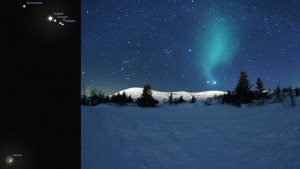Throughout the past few months, Venus and Jupiter have been consistently the brightest two objects visible in the night sky (besides the moon) appearing in the west shortly after sunset. Jupiter is the largest and most massive planet in the solar system, yet Venus is the planet that comes closest to our world. On June 30th, Venus and Jupiter made their closest approach to one another as seen from Earth—a conjunction—coming within just 0.4° of one another, making this the closest conjunction of these two worlds in over 2,000 years.
And yet throughout all this time, and especially notable near its closest approach, Venus far outshines Jupiter by 2.7 astronomical magnitudes, or a factor of 12 in apparent brightness. You might initially think that Venus’s proximity to Earth would explain this, as a cursory check would seem to show. On June 30th Venus was 0.5 astronomical units (AU) away from Earth, while Jupiter was six AU away. This appears to be exactly the factor of 12 that you need.
Only this doesn’t explain things at all! Brightness falls off as the inverse square of the distance, meaning that if all things were equal, Venus ought to seem not 12 but 144 times brighter than Jupiter. There are three factors in play that set things back on the right path: size, albedo, and illumination. Jupiter is 11.6 times the diameter of Venus, meaning that despite the great difference in distance, the two worlds spanned almost exactly the same angular diameter in the sky on the date of the conjunction. Moreover, while Venus is covered in thick, sulfuric acid clouds, Jupiter is a reflective, cloudy world, too. All told, Venus possesses only a somewhat greater visual geometric albedo (or amount of reflected visible light) than Jupiter: 67 percent and 52 percent, respectively. Finally, while Venus and Jupiter both reflect sunlight toward Earth, Jupiter is always in the full (or almost full) phase, while Venus (on June 30th) appeared as a thick crescent.
All told, it’s a combination of these four factors—distance, size, albedo, and the phase-determined illuminated area—that determine how bright a planet appears to us, and all four need to be taken into account to explain our observations.
Don’t fret if you missed the Venus-Jupiter conjunction; three more big, bright, close ones are coming up later this year in the eastern pre-dawn sky: Mars-Jupiter on October 17, Venus-Jupiter on October 26, and Venus-Mars on November 3.
Keep watching the skies, and enjoy the spectacular dance of the planets!
Image credit: E. Siegel, using the free software Stellarium (L); Wikimedia Commons user TimothyBoocock, under a c.c.-share alike 3.0 license (R). The June 30th conjunction (L) saw Venus and Jupiter pass within 0.4° of one another, yet Venus always appears much brighter (R), as it did in this image from an earlier conjunction.

